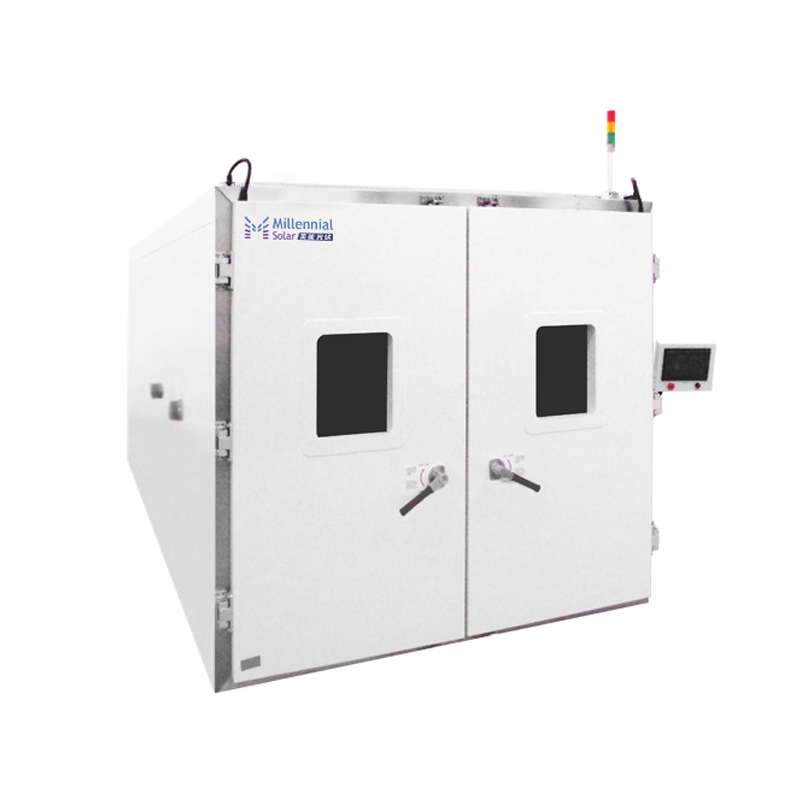
Quantum Efficiency Tester
PL/EL Integrated System
PV-Reflectumeter
3D Confocal Microscope
In-Line Four Point Probe Tester
Four Point Probe Tester
In-Line Thin Film Thickness Tester
Raman Spectrometer
FTIR Spectrometer
Spectrophotometer
Automatic Spectroscopic Ellipsometer
Contact Resistance Tester
Ultra depth of field 3D microscope
Auto Visual Tester
VMM PV Vision Measuring Machine
Solar Cell Horizontal Tensile Tester
Steady State Solar Simulator for Solar Cell
Solar Cell UV Aging Test Chamber
Solar Cell Comprehensive Tensile Tester
Visual Inspection Tester
Wet Leakage Current Tester
PV Module EL Tester
PV Module UV Preconditioning Chamber
Steady State Solar Simulator for PV Module
Current Continuous Monitor
Potential Induced Degradation Test
Bypass Diode Tester
LeTID Test System
Reverse Current Overload Tester
Impulse Voltage Tester
Hipot Insulation Tester
Ground Continuity Tester
Hipot Insulation Ground Tester
Damp Heat Test Chamber
Humidity Freeze Test
Thermal Cycle Test Chamber
Dynamic Mechanical Load Tester
Static Mechanical Load Tester
Hail Impact Tester
Robustness of Termination Tester
Module Breakage Tester
Cut Susceptibility Tester
Peel Shear Strength Tester
Universal Testing Machine (Single-arm)
Universal Testing Machine (Double-arm)
Glass Transmittance Tester
Acetic Acid Test Chamber
EVA Degree of Crosslinking Test System
Junction Box Comprehensive Tester
Drop ball tester
Semi-automatic scanning four-probe tester
Stylus Profilometer
Maximum Power Point Tracker
Perovskite Glass Transmittance Tester
Perovskite P1 Laser Scribing Multifunctional Testing Machine
Perovskite Online PL Tester
Perovskite Online Sheet Resistance Tester
Online Perovskite Film Thickness Tester
Perovskite Process Inspection Workstation
Portable IV Curve Tester
Portable EL Tester
Portable Thermal Imaging Tester
Solar Module Multi-Channel Testing System
PV Inverter Power Quality Tester
Drone EL Tester
IV Tester
IVEL Cell Sorting Machine
Bifacial Solar Panels
Date : 2023-12-07Views : 125
Compared with traditional solar panels, there is a type of panel that can provide up to 50% of solar energy. This is the double-sided solar panel we will introduce in this issue. Industry insiders predict that in the next four years, the double-sided solar panel market will increased tenfold, the main reason is that production costs are increasingly competitive with industry standard single-sided solar panels. Millennial Solar will be bringing information about bifacial solar panels.
![]()
What are bifacial solar panels
A bifacial solar panel is a bifacial energy factory that converts sunlight into electricity on its top and bottom. They differ from monofacial solar panels which use only one side for solar energy production. Bifacial solar panels feature solar cells on both the top and bottom of the panel. They are usually monocrystalline, although polycrystalline can be used. Because they are thin, similar to thin-film panels, bifacial solar panels are also often frameless.
The top of each solar module is covered with protective glass. The reverse side can be glass or transparent. This differs from traditional solar panel systems that have opaque backings. The hardware used to install bifacial solar arrays is designed to minimize shadowing. This means only very narrow support rails and only vertical supports at the corners. The junction box, usually located on the back, is smaller than a traditional solar array. Therefore, it takes up less space and casts less shadow on the backside solar cells to provide more solar energy.

![]()
Working principle
The top solar cells of a bifacial solar panel system face the sun, so they capture incoming sunlight directly, absorbing only certain wavelengths. The top solar cells function similarly to a traditional solar panel array.
Bottom solar cells absorb light reflected from the ground. This light is called albedo light. White or light colors reflect better than dark colors. Painting a white or silver finish on your roof or concrete driveway underneath the panels can provide the same effect. Studies show that white surfaces reflect more than 80% of the albedo light.
To optimize bottom-side cell operation, it is preferred to use high-quality silicon in monocrystalline cells. Unlike single-sided solar panel systems that are placed in racks parallel to surfaces such as roofs, bihedrals produce more energy when angled at different angles to the roof or ground.
Since sunlight reflects off everything at many different angles, bifacial solar panels are better able to capture more objects. They are even more efficient on cloudy days, where single-sided solar cells are at a greater disadvantage.
There are other installation setups that take advantage of the Earth's daily rotation relative to the Sun. To generate two peaks of energy throughout the day, half of the array's double faces could be tilted east to capture sunrise and morning light; the second half, to the west, absorb afternoon intensity and sunset light.
Another alternative is to place the duplex vertically. This arrangement will also have a double peak each day. The reflection of sunlight from the other side of the solar panels will also contribute to energy production during each peak period. One advantage of vertical systems is that blowing snow or sand does not impede their functionality.
Due to the glass covers on both sides of bifacial solar panels, they are more durable than traditional solar panel systems. Therefore, in some cases extended five-year warranty (i.e. 30+ years vs. 20-25 years).

![]()
Temperature and Humidity-freeze Test Chamber

E-mail: market@millennialsolar.cn
Temperature and Humidity-freeze Test Chamber adopts an intelligent energy-saving control method, and PID controls the solenoid valve switch to output cooling capacity or PID controls the heating wire according to the temperature requirements in the box. It is equipped with an evaporation pressure regulating valve to accurately control the evaporator temperature and prevent the evaporator from freezing during humidity control; Equipped with independent return air and exhaust temperature control loops; oxygen-free copper tube gas shielded welding and a series of energy-saving and emission reduction processes.

































































